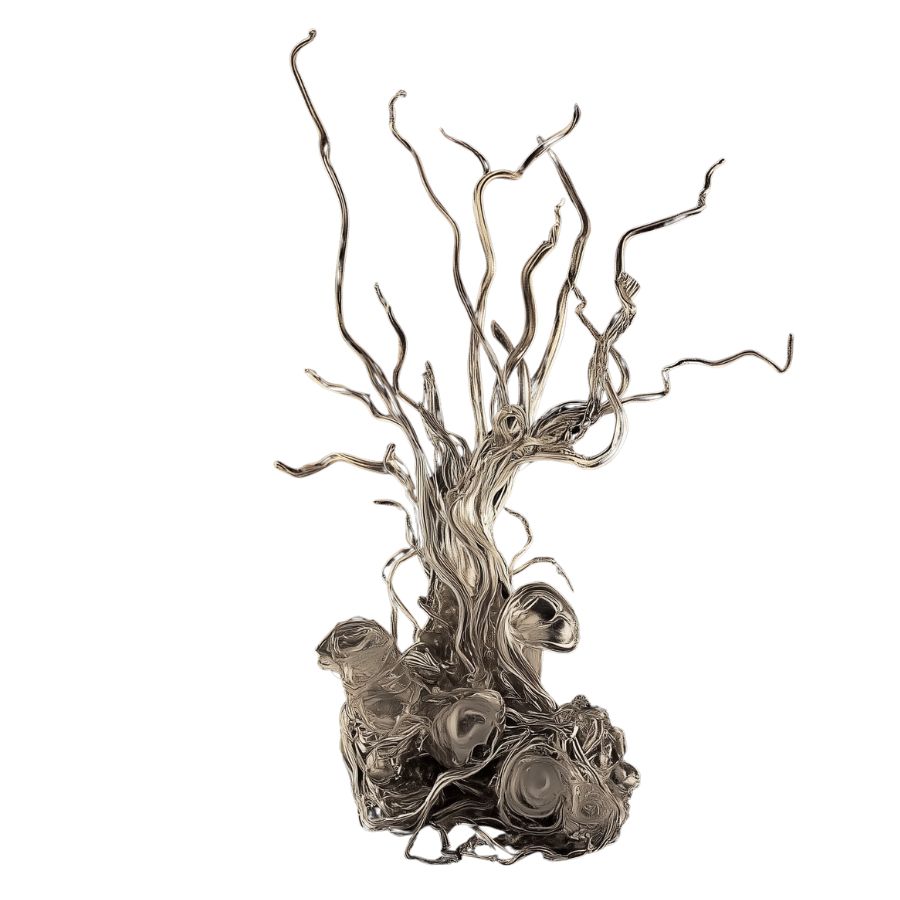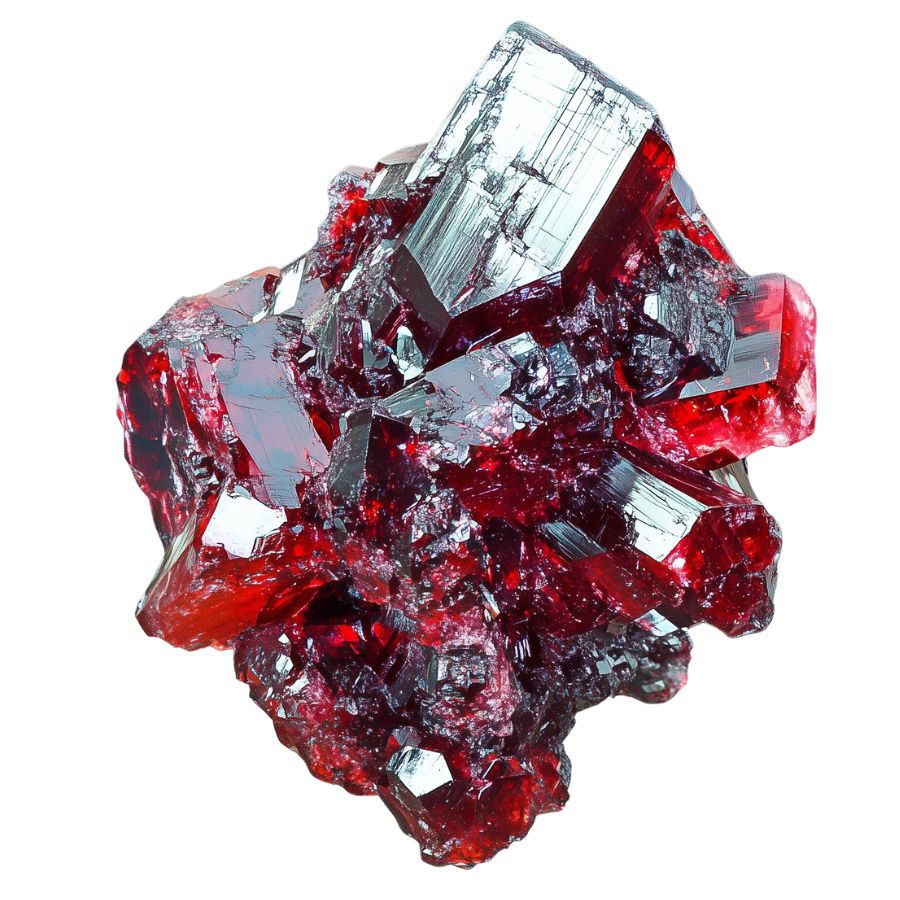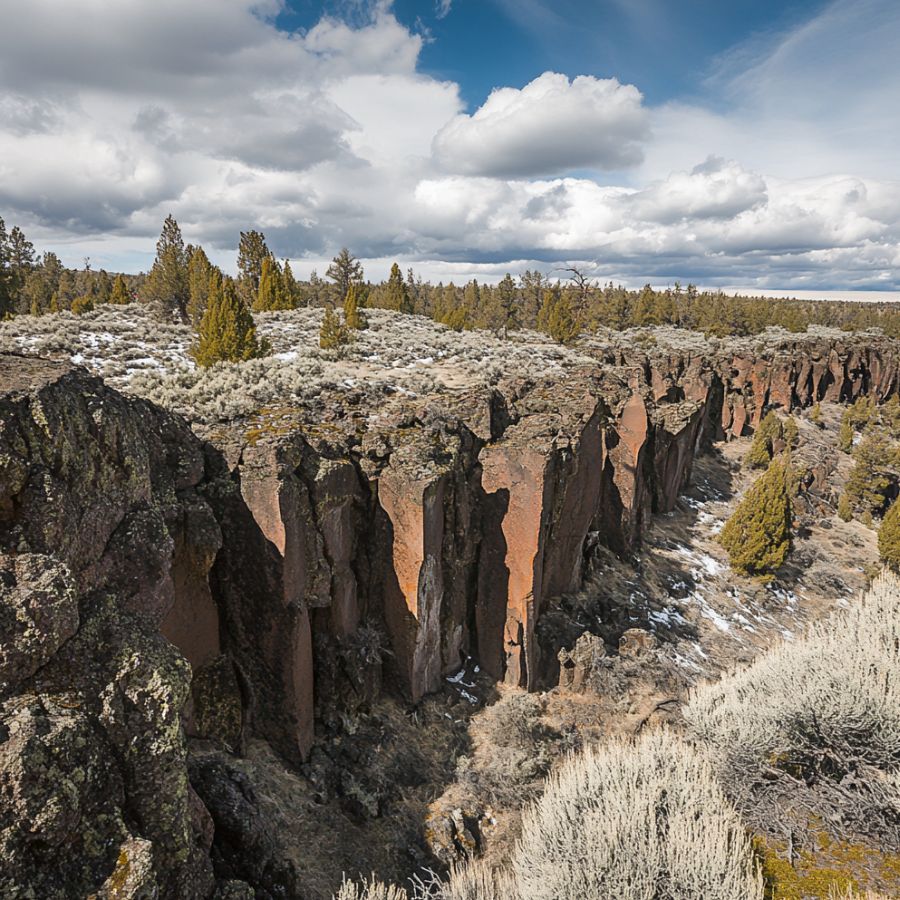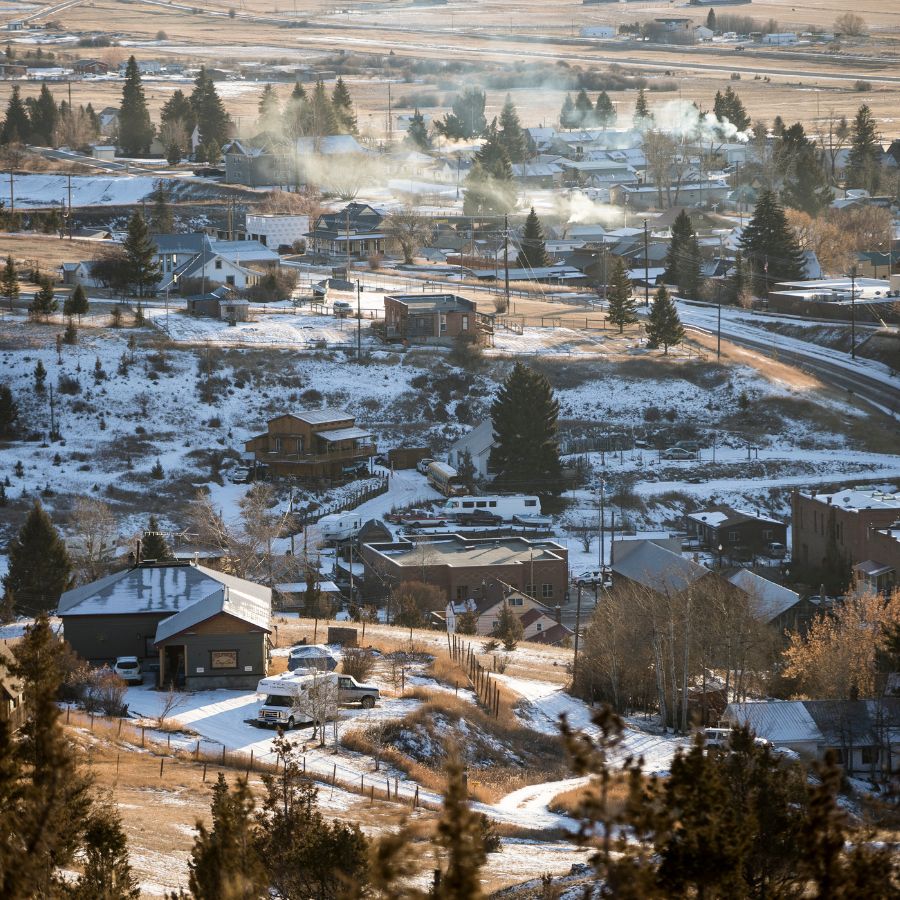Montana has a long history of silver mining, and there are still many opportunities for those looking to find silver.
While silver may not be as common as other minerals, there are still places where it can be found in Montana, especially in areas that were once home to booming mining towns.
You can narrow down your search to the best areas where silver has been found. With some patience and the right information, you’ll be able to explore these areas and increase your chances of discovering silver in Montana.
How Silver Forms Here

Silver forms when super-hot fluids, heated by magma deep underground, flow through cracks in rocks. These fluids, rich in minerals, carry dissolved silver along with other metals.
As these hot solutions cool down and move upward, they deposit silver in veins within the rock.
Often, silver combines with sulfur to create argentite, the most common silver ore. Sometimes, it mixes with other elements like chlorine or forms pure silver threads.
The process happens slowly, over millions of years, as these mineral-rich fluids repeatedly fill and crystallize in underground fractures. The best deposits usually form where there’s a lot of volcanic activity.
Types of Silver Found in the US
The US is home to many silver types, and our state boasts some noteworthy examples as well. Each type showcases its own unique beauty and intriguing characteristics, such as:
Native Silver Flakes

Native silver flakes display a stunning silvery-white color with a bright metallic shine. These thin, plate-like formations often show interesting branching patterns called dendritic structures.
The flakes can range from paper-thin to slightly thicker plates, each with its own unique pattern and formation.
These specimens are pure elemental silver, occurring naturally without combining with other elements. This purity gives them their characteristic bright, untarnished appearance when freshly exposed.
The formation process creates remarkable and intricate shapes resulting in each flake having a unique structure, some showing tree-like patterns while others form geometric shapes. The branching patterns are particularly fascinating, resembling miniature silver trees.
The flakes sometimes appear as overlapping layers, creating complex three-dimensional structures. These formations result from specific geological conditions where silver compounds were naturally reduced to pure silver.
Native silver flakes are highly sought after due to their purity and their unique structures. The more bizarre the formation—such as branching or twisted structures—the higher the value among collectors.
Native Silver Wires

Native silver wires present as delicate, hair-like strands that often curl and twist into fascinating formations. Fresh specimens show a brilliant silver color, though they may darken over time due to natural tarnishing.
The purity of these wires is remarkable, often exceeding 99.7% silver. Their structure shows unique growth patterns, with individual strands that can be incredibly long compared to their width. Some specimens show length-to-width ratios greater than 20, creating impressive specimens.
The internal structure of these wires reveals interesting features called twins – areas where the crystal structure changes direction.
This twinning creates unique patterns visible under magnification and contributes to the wire’s ability to bend and twist into various shapes.
These specimens often maintain their shape despite their delicate appearance. The natural formation process creates stronger structures than you might expect from such thin strands.
Galena

Galena showcases a striking lead-gray color with a brilliant metallic shine when freshly exposed. Its surface can develop a duller appearance over time, creating an interesting aging effect.
The crystal structure forms perfect cubes and eight-sided shapes called octahedra, making it easily recognizable.
One of the most fascinating aspects of galena is its weight. It feels surprisingly heavy in hand compared to other minerals of similar size. This high density comes from its rich lead content, which also makes it the primary source of lead worldwide.
Galena played a crucial role in early wireless communication. Its natural semiconductor properties made it an essential component in crystal radio receivers.
Ancient civilizations recognized its value as early as 3000 BC, using it for various metallurgical purposes.
SAFETY WARNING: Handling Galena requires extreme caution. It has high lead content that makes it toxic if ingested or inhaled. Always wash hands after handling, wear gloves, and never lick or taste the mineral.
Chlorargyrite

Chlorargyrite displays an intriguing pearly gray to brown color, often forming cube-shaped crystals. Its surface shows a unique silky to resinous shine, setting it apart visually. The mineral frequently appears as crusts or coatings, creating interesting surface patterns.
Perhaps the most captivating feature of chlorargyrite is its response to light. When exposed to sunlight, it undergoes a remarkable transformation, changing color to various shades of gray or purple. This happens as the mineral breaks down into pure silver, demonstrating a fascinating natural process.
The formation of chlorargyrite involves an interesting geological process called supergene enrichment. This occurs when metals dissolve from their original minerals and concentrate in new locations, creating pure deposits of chlorargyrite.
This mineral’s light sensitivity made it valuable in the early days of photography. Before modern photographic techniques, chlorargyrite’s natural properties helped capture some of the first photographs, marking a significant milestone in technological history.
Electrum

Electrum presents a fascinating range of colors from pale to bright yellow, depending on its gold and silver content. Its metallic surface shows a softer gleam than pure gold, which earned it the historical nickname “white gold” in ancient times.
The composition of electrum varies significantly, containing anywhere from 20% to 80% gold, with silver making up the remainder. This natural variation creates unique pieces with distinct appearances and properties.
This metal alloy holds a special place in economic history as the material used for the world’s first coins. Around 625-600 BC, the kingdom of Lydia began minting electrum coins, revolutionizing trade and commerce in the ancient world.
The name “electrum” comes from the Greek word for amber, reflecting its pale golden color. Ancient texts, including Homer’s Odyssey, mention this precious metal alloy, highlighting its importance in classical civilization.
Acanthite

Acanthite presents as dark gray to black crystals with a distinctive metallic shine. These crystals often form elongated prisms or tubes, and sometimes appear in pseudo-cubic shapes.
An interesting feature of acanthite is its ability to change form at different temperatures. Above 173°C, it transforms into a different crystal structure called argentite. This transformation can create unique patterns and shapes in the specimens.
The crystals often group together in complex arrangements, forming branching or tree-like structures. These intricate formations make each specimen unique and visually striking.
Acanthite is considered one of the most important silver ores, second only to argentiferous galena. Its high silver content makes it particularly valuable for collectors and rockhounds.
Proustite


Proustite displays a stunning deep red to scarlet color that immediately catches the eye. Its crystal formations range from delicate prisms to rhombohedral shapes, sometimes reaching up to 8 centimeters in size. The surface shows a glass-like shine that gives specimens an extra touch of beauty.
Its specific gravity ranges from 5.57 to 5.64, indicating a high density due to its silver content.
An interesting feature of proustite is its reaction to light. When exposed to sunlight for extended periods, the bright red color gradually darkens and becomes opaque. This sensitivity makes proper storage essential for maintaining the specimen’s original beauty.
The crystals often form in complex groups, creating striking visual displays. Each crystal can show different faces and angles, making every specimen unique.
Some pieces show perfect crystal formations, while others appear in massive or granular clusters.
SAFETY WARNING: Proustite contains arsenic and should be handled with caution. Always wash hands after handling, avoid creating dust, and never lick or taste specimens.
Sphalerite

Sphalerite comes in an impressive range of colors, from yellow and brown to black and even colorless. This variety in color makes each piece unique.
Sphalerite typically crystallizes in a cubic system, appearing as dodecahedral or tetrahedral crystals, though massive forms are more common.
One of the most fascinating features of sphalerite is its ability to produce light. When scratched or broken in the dark, it creates a brief flash of light – a phenomenon called triboluminescence.
It also glows under ultraviolet light, showing yellow-orange or blue colors depending on its composition.
The crystal surfaces have a distinct shine that can range from diamond-like to resinous. Pure specimens might be transparent, while others are completely opaque. The way light plays off these surfaces can create beautiful effects.
Some specimens show color zoning, where different shades appear in bands or patches within the same crystal. These patterns form naturally during the crystal’s growth and add to its visual appeal.
Pyrite with Trace Silver

Pyrite shines with a bright, brassy-yellow color that earned it the nickname “fool’s gold.” The crystals form perfect cubes, eight-sided shapes, or combinations of both. The surface gleams with a metallic brightness that stays brilliant even after long exposure.
Pyrite has a hardness rating of 6–6.5 on the Mohs scale, making it relatively durable compared to other minerals. It is also non-magnetic and does not fluoresce under ultraviolet light, which are useful characteristics for identification.
Many specimens show striations – fine parallel lines on the crystal faces. These natural markings are like nature’s fingerprints, making each piece distinct.
The surfaces can also develop an iridescent tarnish that adds rainbow colors to the golden shine.
Pyrite has been used historically for various applications, including as a source of sulfur for sulfuric acid production. Its ability to emit sparks when struck against metal made it valuable in fire-starting tools before modern ignitions were developed.
Pyrargyrite

Pyrargyrite shows a beautiful deep red-to-red-gray color that resembles fine ruby. When you look at it closely, you can see its brilliant shine that ranges from glass-like to metallic. The crystals often form in striking prismatic shapes with natural lined patterns on their surfaces.
One fascinating aspect is how the color changes when you move the stone around in light. The deep red can shift to darker tones, creating an interesting play of color.
When scratched, it leaves a distinctive purplish-red mark, which helps identify genuine specimens.
The crystals can form in various ways, from single prisms to complex groups. Sometimes they create star-like patterns or clusters that catch light from multiple angles. These formations make each piece unique and visually striking.
SAFETY WARNING: Pyrargyrite contains antimony, which can be toxic. Always handle with care, avoid creating dust, and wash hands after touching specimens. Keep away from children and store in well-ventilated areas.
Polybasite

Polybasite appears black at first glance but holds a surprising secret. When held up to strong light, it reveals beautiful dark ruby-red reflections from within. These internal flashes of color make each specimen special and exciting to examine.
The crystals typically form thin, plate-like shapes that sometimes group together in rose-like patterns. This distinctive growth pattern creates interesting layers that catch light differently from various angles.
An interesting feature of polybasite is its ability to form two different crystal structures – trigonal and monoclinic. This dual nature isn’t common in minerals and makes each piece potentially unique in its formation.
Freieslebenite

Freieslebenite displays a pale steel-gray to silver-white color with a bright metallic shine. The crystals often show clear striped patterns along their length, making them easily recognizable.
It is named after Johann Carl Freiesleben, a notable mining commissioner—which adds to its allure among enthusiasts who appreciate the stories behind mineral discoveries.
The crystals frequently form as long, prismatic shapes. They sometimes appear alone, but often grow together in groups that create striking geometric patterns. The surface shine stays consistent even as you turn the specimen in different directions.
The mineral often contains small inclusions of other minerals, which can create interesting patterns within the crystals. These natural imperfections add character to each specimen and make every piece unique.
SAFETY WARNING: Freieslebenite contains lead and antimony, making it potentially hazardous. Always handle with care, avoid creating dust, and wash hands thoroughly after handling. Keep specimens in sealed containers and away from children.
What Rough Silver Looks Like
Identifying a rough silver might seem tricky, but with a few tips, you can spot one even if you’re not a rock expert. We’re going to give you some great tips now.
Real quick before we jump into that we wanted to cover rock and mineral identification in general.
Look for the Distinct Metallic Sheen

Raw silver typically shows a bright, metallic luster which is a whiter, more platinum-like shine. When tarnished, it’ll have dark gray or blackish patches.
Fresh surfaces exposed by scratching will reveal that characteristic silvery-white color.
Pro tip: Use your phone’s flashlight to check how light reflects off the surface – genuine silver will maintain its whitish gleam even under bright light.
Check the Malleability with a Gentle Scratch

Got a copper penny? Try scratching the stone gently. Silver’s pretty soft (2.5-3 on the Mohs scale) and will actually leave a silvery streak.
If it’s super hard or leaves a dark streak, you’re probably looking at something else. The surface might show some natural indentations or marks because of silver’s softness.
Examine the Surface Texture

Real silver ore often appears in thread-like or wire-like formations. Sometimes you’ll spot cube-shaped or octahedral crystals.
The surface usually isn’t smooth – expect a somewhat dendritic (tree-like) or reticulated pattern. Run your finger across it; authentic silver ore feels surprisingly heavy for its size and slightly greasy to the touch.
Test the Temperature Conductivity

Here’s a cool trick: hold the stone in your palm for 30 seconds. Silver’s an excellent conductor, so it’ll quickly warm up to your body temperature. If it stays cold longer, it might be another mineral.
Also, check if water droplets spread out quickly on the surface – silver’s high conductivity causes this distinctive behavior.
A Quick Request About Collecting
Always Confirm Access and Collection Rules!
Before heading out to any of the locations on our list you need to confirm access requirements and collection rules for both public and private locations directly with the location. We haven’t personally verified every location and the access requirements and collection rules often change without notice.
Many of the locations we mention will not allow collecting but are still great places for those who love to find beautiful rocks and minerals in the wild without keeping them. We also can’t guarantee you will find anything in these locations since they are constantly changing.
Always get updated information directly from the source ahead of time to ensure responsible rockhounding. If you want even more current options it’s always a good idea to contact local rock and mineral clubs and groups
Tips on Where to Look
Once you get to the places we have listed below there are some things you should keep in mind when you’re searching:
Rocky Cliffs and Outcrops

Start by looking at exposed rock faces, especially those with white or gray quartz veins running through them. Silver often hides in these veins alongside other shiny minerals.
The surrounding rock might have a rusty red or dark gray color. Bring a rock hammer and safety glasses, and carefully check any chunks of rock that feel unusually heavy for their size.
Creek Bottoms

Get yourself a gold pan and head to creeks near old mining areas. Look for places where the water slows down – like behind big rocks or at sharp bends.
Silver is heavy, so it settles in the same spots where you might find black sand. Focus on the bottom layer of sand and gravel when panning. The silver will often appear as small, shiny flakes or nuggets.
Old Mine Areas

Search through rock piles near historic mining sites (with permission). Miners often missed smaller pieces of silver-bearing rock.
Look for rocks with a gray metallic shine or those that are surprisingly heavy. A UV light can help, as some silver minerals glow under ultraviolet light.
Always wear sturdy boots and watch for unstable ground.
Rock Cracks and Caves

Silver deposits often form in cracks and small caves where mineral-rich water once flowed. Look for areas where different types of rock meet, especially where light-colored granite touches darker rock.
These contact zones are prime spots for silver deposits. Bring a flashlight and look for metallic streaks or patches on the walls.
Mountain Stream Banks

Check eroded stream banks in mountainous areas, especially after heavy rains. Silver-bearing rocks often wash out of higher ground and collect along stream edges.
Look for unusually heavy pieces with a metallic luster. The best spots are usually where the stream makes a sharp turn or where several smaller streams come together. Dig a few inches into the gravel at these points.
Some Great Places To Start
Here are some of the better places in the state to start looking for silver:
Always Confirm Access and Collection Rules!
Before heading out to any of the locations on our list you need to confirm access requirements and collection rules for both public and private locations directly with the location. We haven’t personally verified every location and the access requirements and collection rules often change without notice.
Many of the locations we mention will not allow collecting but are still great places for those who love to find beautiful rocks and minerals in the wild without keeping them. We also can’t guarantee you will find anything in these locations since they are constantly changing.
Always get updated information directly from the source ahead of time to ensure responsible rockhounding. If you want even more current options it’s always a good idea to contact local rock and mineral clubs and groups
Butte

Butte started as a gold and silver mining camp in the late 1800s, with silver discoveries fueling the city’s early growth. By the turn of the century, it became one of the largest mining towns in the American West, thriving on silver production before copper took over as the dominant resource.
The city saw an influx of immigrants who came to work in the silver mines, which helped shape its unique and diverse cultural landscape.
Although copper later overshadowed silver, Butte’s rich history in silver mining remains an important part of its legacy.
Philipsburg

In the late 1800s, the discovery of silver brought prospectors to the area near Philipsburg, sparking a mining boom. The town of Granite, just northeast of Philipsburg, became a bustling mining center, with mines like the Granite Mountain Mine producing millions in silver.
While the area became known for its silver, miners also sought other valuable minerals, including sapphires found in Rock Creek.
Today, the remnants of the once-thriving mining town of Granite can be explored at Granite Ghost Town State Park, offering a glimpse into the area’s rich mining history.
Elkhorn

Elkhorn was once a bustling silver mining town founded in 1872, with families settling there instead of just single male miners. The town reached its peak with a population of 2,500, featuring schools, hotels, and social spaces like Fraternity Hall.
After silver prices dropped and a diphtheria epidemic claimed many lives, the town started to decline and was largely abandoned by the early 1900s.
Today, Elkhorn is a state park, with well-preserved buildings like Fraternity Hall and Gillian Hall still standing for visitors to explore.
Sanders County

Sanders County has seen significant growth in recent years, with its population rising from 8,000 to about 11,300. The county features a variety of mining districts where silver has been discovered, contributing to its economic history.
With a mix of towering mountain ranges, timberlands, and vast prairie basins, the county supports industries like agriculture, mining, and lumbering.
The Clark’s Fork of the Columbia River runs through the county, providing vital water resources for the area and contributing to its diverse landscape.
Stillwater Complex

The Stillwater Complex is a significant geological feature, known for its layered intrusion and its role in understanding magmatic ore deposits. It spans about 50 km along the northern front of the Beartooth Mountains.
The complex contains nickel, copper, and silver-rich sulfides in its lower layers, and chromite seams in the ultramafic series were mined between the 1940s and early 1960s.
The discovery of the J-M Reef in the 1970s revealed a world-class platinum-group element deposit, which remains the highest-grade source of these elements in the United States.
Places Silver has been found by county
After discussing our top picks, we wanted to discuss the other places on our list. Below is a list of the additional locations where we have succeeded, along with a breakdown of each place by county.
| County | Location |
| Silver Bow County | Divide Creek Mining District |
| Silver Bow County | Highland Mining District |
| Silver Bow County | Moose Creek Mining District |
| Silver Bow County | Old Glory Mine |
| Beaverhead County | Argenta Mining District |
| Beaverhead County | Baldy Mountain area mines |
| Beaverhead County | Bannack Mining District |
| Beaverhead County | Blue Wing Mining District |
| Beaverhead County | Hecla Mining District |
| Beaverhead County | Jake Canyon |
| Beaverhead County | Pioneer Mining District |
| Beaverhead County | Quartz Hill |
| Blaine County | Bear Paw Mining District |
| Cascade County | Neihart Mining District |
| Deer Lodge County | Anaconda Range |
| Deer Lodge County | Gold Coin Mining District |
| Fergus County | Warm Springs District |
| Flathead County | Flathead Mining District |
| Granite County | First Choice Mining District |
| Jefferson County | Boulder Batholith |
| Jefferson County | Cataract Mining District |
| Jefferson County | Homestake Mining District |
| Jefferson County | Lowland Mining District |
| Jefferson County | Pipestone Mining District |
| Jefferson County | Whitehall Mining District |
| Lewis and Clark County | Spring Hill Mining District |
| Lewis and Clark County | Marysville Mining District |
| Lewis and Clark County | Ophir Mining District |
| Lewis and Clark County | Vaughn Mining District |
| Lincoln County | Troy Mining District |
| Madison County | Alder Gulch |
| Madison County | McCartney Mountain |
| Madison County | Whitehall Mining District |
| Madison County | Potosi Mining District |
| Madison County | Rochester Mining District |
| Madison County | Sheridan Mining District |
| Madison County | Silver Star Mining District |
| Madison County | South Boulder Mining District |
| Madison County | Tidal Wave Mining District |
| Madison County | Washington Mining District |
| Mineral County | Carter Mining District |
| Mineral County | Cedar Creek Mining District |
| Mineral County | Denemora Mining District |
| Mineral County | East Coeur D’Alene Mine |
| Mineral County | Pardee Creek |
| Mineral County | Packer Creek Mining District |
| Mineral County | St. Regis Mining District |
| Missoula County | Nine Mile Mining District |
| Park County | New World Mining District |


